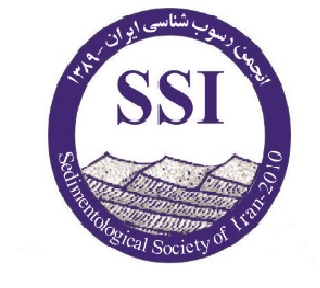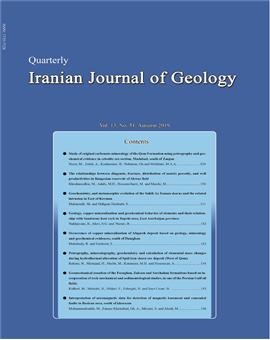Interpretation of aeromagnetic data for detection of magnetic basement and concealed faults in Basiran area, south of khorasan
Subject Areas :Mohammad Mohammadzadeh 1 , GholamAbbas Fanaee Kheirabad 2 , Saba Moradalivand 3 , mahbobe abedisamakosh 4
1 -
2 -
3 -
4 -
Keywords: Basiran area South of Khorasan, Magnetic basement Magnetic lineaments, Aeromagnetic.,
Abstract :
Basiran area in the south of Birjand city is well-known for its important mineral potential and is located in the volcanic region of eastern Iran. . In 2005, the geological survey of Iran (GSI) conducted a high resolution airborne magnetic survey over the area about 850 km2 to create a suitable geospatial database for further explorations and investigations. Aeromagnetic survey is an effective tool for magnetic basement mapping and detecting concealed magnetic lineaments in a volcanic area. This work focuses on two main subjects using aeromagnetic data: (1) depth estimation of sediment sequences (i.e. depth to the magnetic basement), and (2) extracting magnetic lineaments. Necessary corrections such as diurnal, compensation, lag and IGRF applied over the raw aeromagnetic data to generate residual magnetic intensity data. Then, required filters were sequentially applied. They were reduced-to-pole (RTP), upward continuation (UP), Euler and Werner deconvolutions and Tilt derivation (TDR). To estimate the thickness of sedimentary sequences, a combination of depth estimators that were the Euler and Werner were utilized. Consequently, the outputs showed thick volcanic (magnetic basement) outcrops in some portions, and the thick sedimentary sequences that extended from a depth of a few meters to 1200 meters. Magnetic lineament in the form of magnetic fabric and fault were detected by tilt derivation method, in which positive and negative peaks in TDR map were in association with a magnetic fabric in the area. Meanwhile, magnetic fabrics showed small linear magnetic traces which were used for recognition of linear structural pattern. In addition, magnetic faults were detected through implementation of a collection of filters namely TDR of RTP_UP of 50, 200, 500 and 1000 meters. Note that, minor magnetic faults (order 1) were only detectable in the low level TDR_UP, but major ones were detectable in the high level of TDR_UP. This work emphasizes the important role of the magnetic data processing to better understand the relation between magnetic anomalies and the subsurface geology. Totally, more than 20 first and second order faults were identified and mapped
امیرپور اصل، ا. و سهرابی، ق.، 1394. پردازش و تفسیر دادههای مغناطیس هوابرد برای تعیین مرز ساحتارهای مغناطیسی و محل گسلهای مدفون ایران، فصلنامه علوم زمین، 97، 115-122.
فنایی خیرآباد، غ.، 1385. پردازش دادههای مغناطیس هوایی منطقه بصیران با استفاده از اسپلاینهای مکعبی، پایاننامه کارشناسی ارشد ژئوفیزیک، موسسه ژئوفیزیک دانشگاه تهران،96.
فنایی خیرآباد، غ.، حسین زاده، ن.، نمکی، ل. و صداقت، ب.، 1387. پردازش دادههای مغناطیس هوایی منطقه بصیران با استفاده از اسپلاین مکعبی، مجله فیزیک زمین و فضا، 34، 2، 43-51.
فروتن، م. و خیرالهی، ح.، 1393. گسلهای مغناطیسی بنیادی ایران، سازمان زمینشناسی و اکتشافات معدنی کشور.
سایت پایگاه ملی دادههای علوم زمین کشور به نشانی www.ngdir.ir.
سازمان زمینشناسی و اکتشافات معدنی کشور، نقشههای زمینشناسی 1:250000 بیرجند و بصیران.
Aghanabati, A., 1998. Major sedimentary and stuctural units of Iran (map). Geological Survey of Iran.
Arjmandzadeh, R., Karimpour, M. H., Mazaheri, S. A., Santos, S. A. J. F., Medina, J. M. and Homam, S. M., 2011. Sr-Nd isotope geochemistry and petrogenesis of the Chah-Shaljami granitoids (Lut Block, Eastern Iran). Journal of Asian Earth Sciences, 41, 283-296.
Arjmandzadeh, R. and Santos, J. F., 2014. Sr–Nd isotope geochemistry and tectonomagmatic setting of the Dehsalm Cu–Mo porphyry mineralizing intrusives from Lut Block, eastern Iran. International Journal of Earth Sciences (Geologische Rundschau) 103, 123–140.
Arkani-Hamed J., 2007. Differential reduction to the pole: Revisited: Geophysical Journal International, 72,1, L13–L20.
Barghi, B., Calagari, A., Zarrinkoub, M., Simmonds, V., 2018. Geologic and geochemical investigation on the Mn veins in Jonub-E Sehchangi, SW Birjand, Southern Khorasan province (east Iran), Geosciences, 27, 106, 3-12.
Barnov V., 1957. A new method for interpretation of aeromagnetic maps:Pesudo-gravimetric anomalies: Geophysics, 22, 359-383.
Beiki M., 2010. Analytic signals of gravity gradient tensor and their application to estimate source location. Geophysics, 75,6, I59-I74.
Berberian, M., Jackson, J. A., Qorashi, M., Khatib, M. M., Priestley, K., Talebien, M., Ghafuri Ashtiani, M., 1999. The 1997 May 10 Zirkuh (Qaenat) earthquake (M.W7.2): Faulting along the Sistan suture zone of eastern Iran. Geophysical Journal International, 136, 671–694.
Camp, V. E., and Griffis, R. J., 1982. Character, genesis and tectonic setting of igneous rocks in the Sistan suture zone, eastern Iran. Lithos. 15,3, 221-239.
Jung, D., Keller, J., Khorasani, R., Marcks, C. H. R., Baumann, A. and Horn, P., 1983. Petrology of the Tertiary magmatic activity the northern Lut area, East of Iran, Ministry of mines and metals. Geological Survey of Iran, Geodynamic Project (Geotraverse) in Iran 51, 285–336.
Hartman, R. R., Teskey, D. J. and Friedberg, J. L., 1971. A system for rapid digital aeromagnetic interpretation. Geophysics, 36, 891-918.
Karimpour, M. H. Stern, C. R. Farmer, L. Saadat, S. and Malekezadeh, A., 2011. A Review of age, Rb-Sr geochemistry and petrogenesis of Jurassic to Quaternary igneous rocks in Lut Block, Eastern Iran. Journal GeoPetroleum, 1, 19-36.
Korhonen, K., Paanaaen, M. and Paulamaki, S., 2004. Interpretation of lineaments from airborne geophysical and topographic data, Geological Survey of Finland.
Kumar, R., Bansal, A., Anand, S., Roa, V. and Singh, K., 2018. Mapping of magnetic basement in Central India from aeromagnetic data for scaling geology, Geophysical Prospecting, 66, 226–239.
Lotfi, M., 1982. Geological and geochemical investigations on the volcanogenic Cu, Pb, Zn, Sb ore- mineralizations in the Shurab-GaleChah and northwest of Khur (Lut, east of Iran). Unpublished Ph.D thesis, der Naturwissenschaften der Universitat Hamburg, 151.
Mbarga, T.N., Feumoe, A.N.S., Dicoum, E. M. and Fairhead, J. M., 2012. Aeromagnetic data interpretation to locate buried faults in south-east Cameron: Geophysica, 48,1-2, 49-63.
Miller, H. and Singh, V. 1994. Potential field tilt—a new concept for location of potential field sources, Journal of Applied Geophysics, 32, 213-217.
Nabighian, M., V. Grauch, R. Hansen, T. Lafehr and Y. Li et al., 2005. The historical development of the magnetic method in exploration. Geophysics, 70, 33ND-61ND.
Pang, K. N., Chung, S. L., Zarrinkoub, M. H., Khatib, M. M., Mohammadi, S. S., Chiu, H. Y., Chu, CH. H., Lee, H. Y. and Lo, CH. H., 2013. Eocene-Oligocene post-collisional magmatism in the Lut-Sistan region, eastern Iran: Magma genesis and tectonic implications. Lithos. 180, 234-251.
Phillips, J. D., 2002. Processing and Interpretation of Aeromagnetic Data for the Santa Cruz Basin—Patagonia Mountains Area, South-Central Arizona, U.S. Geological Survey Open-File Report.
Reid, A. B., Allsop, J. M., Granser, H., Millet, A. J. and Somerton, I. W., 1990. Magnetic interpretation in three dimensions using Euler deconvolution: Geophysics, 55, 80-91.
Saadat, S., Stern, C. R. and Karimpour, M. H., 2008. Geochemistry of Quaternary Olivine Basalts from the Lut Block, Eastern Iran. American Geophysical Union, Fall Meeting 2008, abstract #T21A-1933.
Saadat, S., Stern, C. R. and Karimpour, M. H., 2009. Quaternary mafic volcanic rocks along the Nayband fault, lut block, eastern iran. Geological Society of America Annual Meeting, 18-21 October.
Tarkian, M., Lotfi, M. and Baumann, A., 1983. Tectonic, magmatism and the formation of mineral deposits in the central Lut, east Iran, Ministry of mines and metals. Geological survey of Iran, Geodynamic Project (Geotraverse) in Iran 51, 357-383. Geological Survey of Iran. Tehran, Iran.
Tirrul. R., Bell, l. R., Griffis, J. R. and Camp, V. E., 1983. The Sistan suture zone of eastern iran. Geological Society of America Bulletin, 94,134-150.
Walker, R. T., Gans, P., Allen, M. B., Jackson, J., Khatib, M., Marsh, N. and Zarrinkoub, M., 2009. Late Cenozoic volcanism and rates of active faulting in eastern Iran. Geophysical Journal International. 177, 783- 805.
Werner, S., 1953. Interpretation of magnetic anomalies at sheet-like bodies: Geophysics, 47,118-123.

